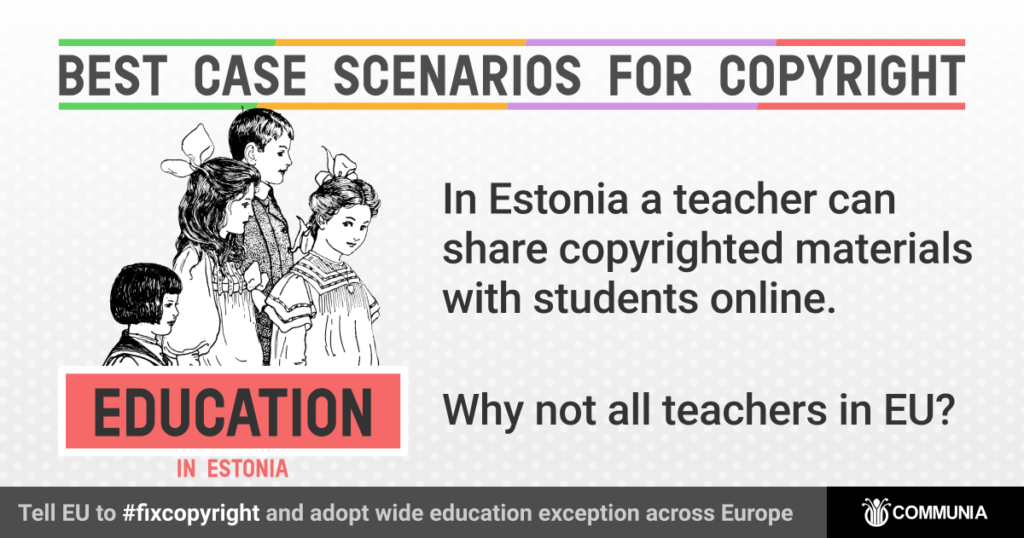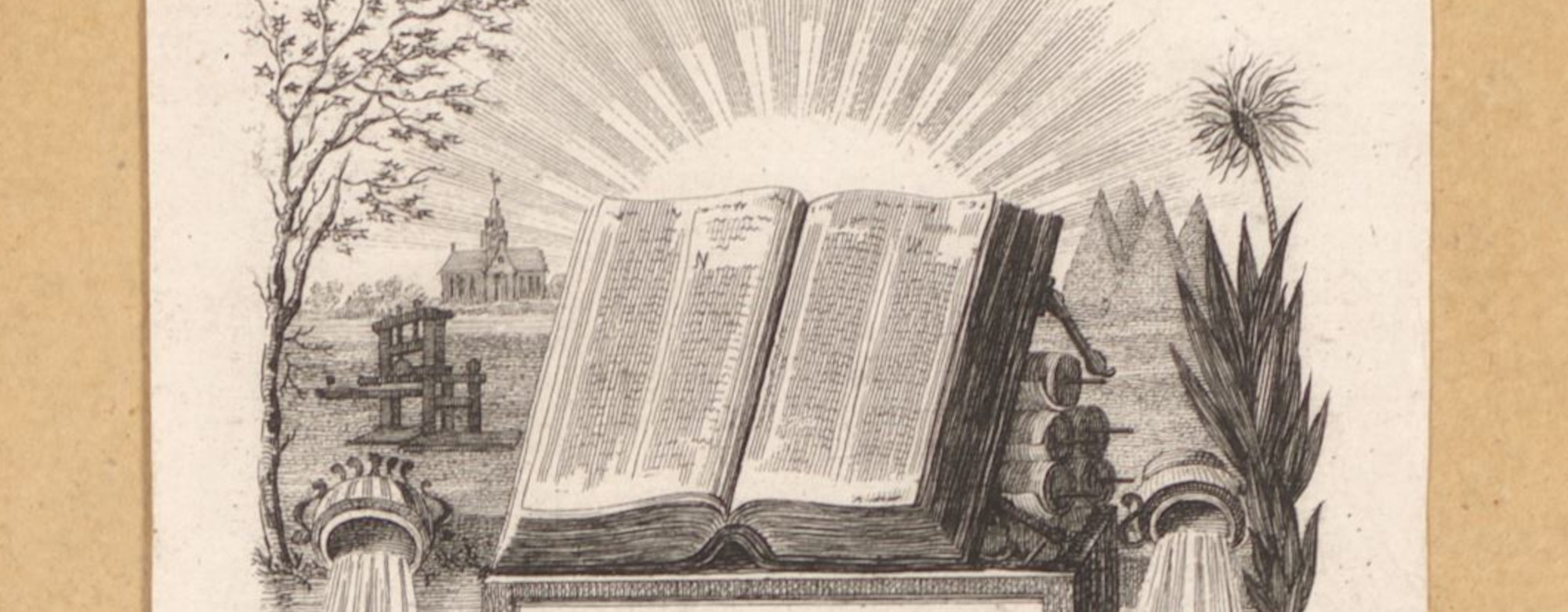The education exception benefits teachers, students, and researchers who need access to all types of educational and informational resources that are often protected by copyright. This exception balances the right to education with the rights of authors. Maintaining the balance is never easy, and some issues still await their interpretation in Estonia. Still, Estonia enjoys the widest education exception provisions among all EU member states.
Within the Best Case Scenarios for Copyright series, we present Estonia as one of the best examples for education. Below you can find the basic facts and for more evidence check the Best Case Scenario for Copyright – Education in Estonia legal study. EU, it’s time to #fixcopyright!
Exception/Limitation: Education
Country: Estonia

What is an education exception?
- An education exception to copyright relates to cases where protected works of all types are used for educational purposes or scientific research, both offline and online.
- The exception is justified by the public interest of access to education.
How does it work?
- All acts that are necessary for educational purposes are exempted: users can copy, adapt, translate, and transform protected works.
- All types of copyrighted materials that are publicly available can be used for teaching and study, including films, phonograms, and broadcasts.
- It is possible to use a protected work to the extent required to fulfill the purpose of a particular teaching or scientific activity. If the use of an entire work is necessary, it also falls under the exception.
- It is mandatory to credit the author of the protected work.
Who can use it?
- Anyone can benefit from the general teaching and scientific exception, including citizens, organizations, and educational institutions.
- Physical copies of works may be created by educational and research institutions, and by citizens in general for research and private study, under other exceptions.
- Only educational institutions may take advantage of the right to organize recitals, plays, dance shows, etc., based on a protected work, performed in front of an audience. (see “limits” point 3).
Is it free?
It depends. No remuneration is due to the authors or rights holders of the works used for the educational purpose as long as no physical copies of the works are made.
What are the limits to the education exception?
- Educational or scientific purpose is required – it is possible to use a work in education and scientific research, including in lectures, tests and teaching compilations, as long as it illustrates the process of teaching, learning or research.
- Non-commercial use – users may not benefit commercially from the fact that they carry out scientific research or illustrate teaching with copyrighted works under the exception.
- For performances, the audience is limited to the school’s close social circle – to benefit from the exception, a performance must be staged by students and staff for the audience consisting of people directly involved with the school, such as parents and caregivers.
- The three-step test – by law, uses are only exempted if they do not conflict with the normal exploitation of the work, and do not unreasonably prejudice the legitimate interests of the rights holder. A correct application of the three-step test requires a fair balance between the public interest in access to education and the interests of the right holders.
Economic and societal impact
Estonia is one of the most technology-friendly countries in Europe, with widely used e-services for citizens, and excellent internet access. Many educational institutions, teachers, and researchers collect and share educational resources with their students and colleagues, as well as create online courses. This is a crucial trend in advancing the education in times when computers and mobile devices are becoming the primary point of access to knowledge and literacy. Taking advantage of technology in education is possible because of the wide and flexible education exception.
Examples of use
- Estonian Information Technology Foundation for Education keeps a digital repository of thousands of teaching materials from over 60 vocational schools and universities.
- An Estonian history teacher runs a blog, where she publishes her students’ works for further study and dissemination of knowledge.
Law
- Articles: § 19 subsection 2 and 3, and § 22 of the Estonian Copyright Act, adopted on 11 November 1992 (as last amended on 10 April 2016)
- The wording of § 2 section 2 is similar to the 2001 InfoSoc Directive that has been transposed in Estonia in 2004
Why we chose the Estonian example?
We believe that copyright benefits education when it stays out of the classroom. An exception or limitation to copyright for educational purposes must be flexible, neutral with regard to media type, format, and technology, and covering all necessary uses by all sorts of users. In other words, the best scenario for education would be a provision covering all exclusive rights and at least as broad as the EU exception under the InfoSoc Directive, which is only applicable to certain rights (reproduction, communication to the public, making available to the public, and distribution).
As far as we are aware, Estonia is the EU country that has come closest to a literal transposition of the InfoSoc provision. This has been done, however, without restricting the scope of application of the legal provision to certain exclusive rights.
The fact that we have selected the Estonian model does not mean, however, that this example is as good as it could be. There is one main legal provision in the Estonian Copyright Act and two other overlapping exceptions, one of which causes some interpretation issues on who can benefit from reproductions made for educational purposes. There are no court cases on the issue, but the most generous interpretation seems to prevail in educational practice in Estonia. This is probably due to the fact that the Estonian Copyright Act allows, since its original version, broad unauthorized uses of protected materials for educational purposes.
The planned Estonian copyright reform may resolve these issues on the legislative level. We sincerely hope, that the harmonization of EU copyright that includes a mandatory broad educational exception will solve it across Europe first.
Further reference
For details on how the educational exception functions in Estonia please see the Best Case Scenario for Copyright – Education in Estonia analysis prepared by Teresa Nobre, LL.M. IP (MIPLC) and Alari Rammo on behalf of the Communia Association.
- Download the Education in Estonia Factsheet
- Download the Best Case Scenario for Copyright – Education in Estonia
- Download the Best case scenarios for copyright – full brochure
Read more at https://communia-association.org/bcs-copyright
Talk to us: Best Case Scenarios for Copyright: @communia_eu @tenobre @a2na
Best Case Scenarios for Copyright is an initiative by COMMUNIA, presenting best examples of copyright exceptions and limitations found in national laws of member states of the European Union. We believe that, by harmonizing copyright exceptions and limitations across Europe, using as a model these best examples that are permitted within the EU law, the EU would reinforce users’ rights in access to culture and education.

